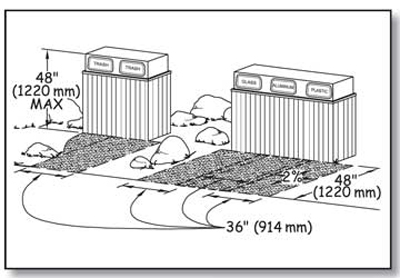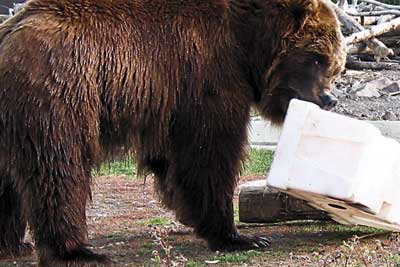Trash, Recycling, and Other Essential Containers
Many recreation areas have trash and recycling containers for visitors' convenience to protect the environment or to discourage visits to the area by wild animals. Some campgrounds also provide bear-resistant food storage containers. Each container must meet the requirements that follow. If containers are provided in a recreation site, connect them to the area's other major features by an outdoor recreation access route. If containers are provided on trails, ensure that routes connecting those containers and the other major constructed features comply with technical requirements for trails rather than outdoor recreation access routes.
In a multibin [sic] container, only half the bins for each purpose must meet the accessibility requirements. For example, if a trash container has four separate compartments, only two of the compartments are required to meet the technical requirements. But all the bins of a recycling container with four separate bins to collect four different types of recyclable materials must meet the requirements. Figure 95 illustrates these requirements.

Figure 95—The requirements for trash and recycling containers.
Provide a clear floor or ground space that is either 36 inches (914 millimeters) by 48 inches (1,220 millimeters) positioned for a forward approach or 30 inches (760 millimeters) by 60 inches (1,525 millimeters) positioned for a side approach to the receptacle opening at each container. The clear space may overlap the clear space for adjacent containers. It must be adjacent to and may overlap the outdoor recreation access route. The slope of the clear space must not be steeper than 1:48 (2 percent) in any direction. When the surface is unpaved or not built with boards, slopes not steeper than 1:33 (3 percent) are allowed if necessary for drainage. Ensure the surface is firm and stable and made from a material consistent with the setting and level of development. However, if a condition for exception in an alteration project at an existing site prohibits full compliance with a specific requirement for clear floor or ground space (surface, slope, size, or location), the clear floor or ground space only has to comply with requirements to the extent practicable.
Ensure controls and operating mechanisms for containers comply with the technical requirements for reach ranges and operability specified in ABAAS, sections 308 and 309, and explained in "Reach Ranges and Operability Requirements" of this guidebook.
An exception is allowed for lids and operating controls designed to deter large animals, such as grizzly bears (figure 96). Large animals pose a threat to humans when they become accustomed to wandering through recreation sites in search of food. Most containers equipped with accessible controls and operating mechanisms can be opened by determined bears. Containers in recreation areas where bears and other large animals pose a risk to humans don't have to comply with accessibility provisions for operating controls until accessible bear-proof containers are available from more than one source. Dumpster type trash and recycling receptacles are not required to comply with the operability requirements.

Figure 96—Grizzly bears have the power and persistence to get food that is not secured properly.

User Comments/Questions
Add Comment/Question